Description
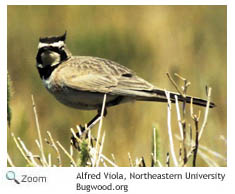 The horned lark is the only lark native to North America. It is 6-8 inches in length and has a wingspan of 12-13 inches. It has a tan back; a black, crescent-shaped patch on its breast; a black stripe on its face; and a black tail. It has a yellow throat and tufts of feathers on its head that look like horns. It has a long,
straight claw on its hind toe called a
larkspur.
The
larkspur
is common on other species of larks. Male and female horned larks look alike, but the female is a little duller in color. The horned lark is also found in
Asia and northern Europe. The horned lark is the only lark native to North America. It is 6-8 inches in length and has a wingspan of 12-13 inches. It has a tan back; a black, crescent-shaped patch on its breast; a black stripe on its face; and a black tail. It has a yellow throat and tufts of feathers on its head that look like horns. It has a long,
straight claw on its hind toe called a
larkspur.
The
larkspur
is common on other species of larks. Male and female horned larks look alike, but the female is a little duller in color. The horned lark is also found in
Asia and northern Europe.
Range 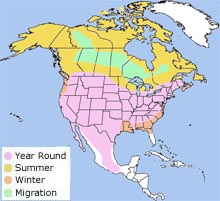 The horned lark breeds across much of North America from Alaska and Canada south to most of the southern states, except for the Deep South. It winters in most of the United States, including the southern states. The horned lark breeds across much of North America from Alaska and Canada south to most of the southern states, except for the Deep South. It winters in most of the United States, including the southern states.
Habitat
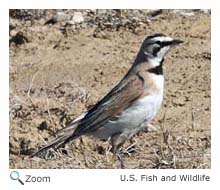 The horned lark is found in open areas and areas with short grass. It is often found in fields, prairies, on lawns, near airports, and along beaches. The horned lark is found in open areas and areas with short grass. It is often found in fields, prairies, on lawns, near airports, and along beaches. | |
Diet
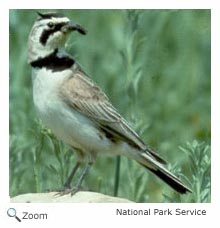 The horned lark eats small seeds from a wide variety of grasses and weeds. It occasionally eats insects, especially in the summer. It may also eat berries and snails. The horned lark eats small seeds from a wide variety of grasses and weeds. It occasionally eats insects, especially in the summer. It may also eat berries and snails.
Life Cycle
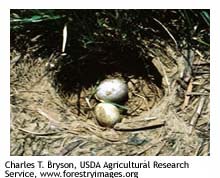 The male horned lark flies above the female in circles and sings. He then dives towards the ground with his wings folded. Just before he hits the ground, he opens his wings and lands. The female lays 2-5 eggs in a nest made of woven grasses and other plants. The nest is lined with feathers and made in a depression in the ground. The female incubates the eggs for 10-14 days. The male and the female feed and care for the chicks. The chicks fledge when they are 9-12 days old, but their parents continue to feed them for a while. The female may have as many as three broods a year. The male horned lark flies above the female in circles and sings. He then dives towards the ground with his wings folded. Just before he hits the ground, he opens his wings and lands. The female lays 2-5 eggs in a nest made of woven grasses and other plants. The nest is lined with feathers and made in a depression in the ground. The female incubates the eggs for 10-14 days. The male and the female feed and care for the chicks. The chicks fledge when they are 9-12 days old, but their parents continue to feed them for a while. The female may have as many as three broods a year.
Behavior
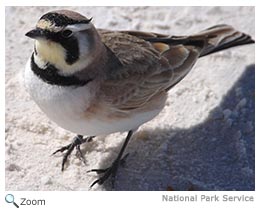 The horned lark is a ground-dwelling bird; it may perch on a fence post or tree stump, but never in a tree. On the ground, it doesn't hop - it walks or runs! It is a very vocal bird and makes a
"tsee-ee" sound. It sings in the air and on the ground. The horned lark is a ground-dwelling bird; it may perch on a fence post or tree stump, but never in a tree. On the ground, it doesn't hop - it walks or runs! It is a very vocal bird and makes a
"tsee-ee" sound. It sings in the air and on the ground.
|

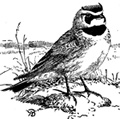

 The horned lark breeds across much of North America from Alaska and Canada south to most of the southern states, except for the Deep South. It winters in most of the United States, including the southern states.
The horned lark breeds across much of North America from Alaska and Canada south to most of the southern states, except for the Deep South. It winters in most of the United States, including the southern states. 


